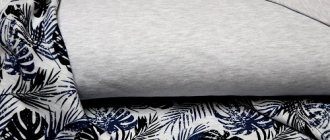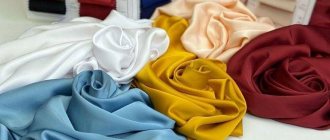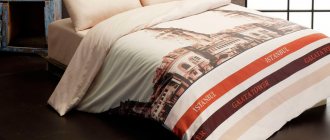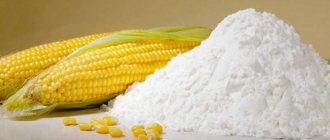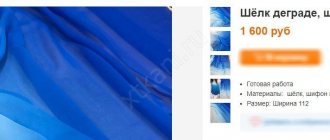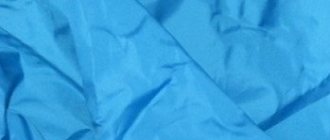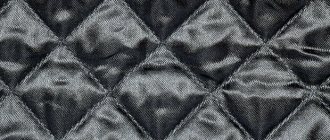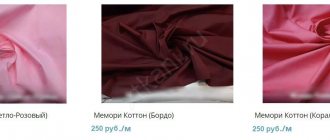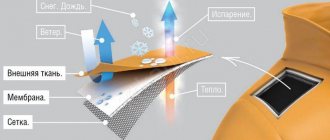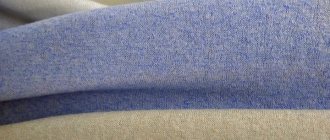Flannel doesn't need much introduction. Many people know what this pleasant-to-touch material looks like. The fabric is well known to us from baby diapers and warm, cozy clothing, which is especially good in cool weather. The name of flannel fabric evokes pleasant memories of childhood and is associated with something warm, soft, tender, home comfort, and the caring hands of a mother. However, not everyone knows about the many less obvious advantages of flannel, about the features and types of this textile, what it is made from, where it is used and how to care for it.
What is flannel
Flannel is a soft, dense fabric with a noticeable fleece in the form of soft pile. Translated from French, “flanelle” means “wool,” and from Old French “flaine” means “blanket.” There are several other versions of the origin of the name of this fabric. According to one of them, the word “flannel” in the language of the Welsh – the indigenous inhabitants of Wales – means “woolen fabric”. It was Welsh craftsmen (England) who were the first to learn how to make this material from sheep wool in the 17th or even 16th century (according to various sources).
Until the beginning of the 20th century, sheep wool was the raw material for the production of flannel fabric. Because of its unusual softness, wool flannel was also called “winter cotton.” Later, cotton flannel appeared, which is very similar in properties to wool.
Nowadays flannel fabric is made mainly from cotton, less often from wool. It often contains viscose, mixed and synthetic fibers.
What does flannel look like?
This cotton, wool, wool blend fabric has a uniform, slightly noticeable pile, making the fabric fluffy. The pile can be double-sided, but usually it is placed on the front side. Thanks to the soft pile, the material gives the body a pleasant tactile sensation.
Despite its tenderness, the canvas is very durable and dense.
The material may have a slight shine if viscose or synthetic fibers are added to the composition.
Flannel fabric can be plain, striped, checkered, with a variety of patterns.
A little history
England, or rather Wales - one of the most conservative regions of the British Empire of the 17th-18th centuries - is considered the birthplace of a soft, but dense and durable material - flannel. Here the local Welsh first wove heavy cloth from combed sheep's wool, which over the centuries evolved into modern flannel fabric.
Initially it was not a cheap material. In addition, it was credited with certain medicinal properties, which made the fabric even more expensive. The effectiveness of flannel in treating diseases, of course, has not been proven. Although in the book about Gulliver's adventures by the English writer Jonathan Swift there is a description of the treatment of inflamed joints, which were first rubbed with cognac and then wrapped in soft flannel.
The Welsh, who knew many secrets of fabric production, learned, among other things, to produce multi-colored fabrics from pure wool. In this case, no dyes or staining were used. Black, brown, white yarn of natural colors obtained from sheep's wool were woven together in different proportions. To obtain wool of light shades, it was bleached with sulfur dioxide.
Over time, the material appeared in other European countries and in Russia, thanks to Peter I.
Place and history of origin
Flannel was first woven in the 17th century by Welsh craftsmen, who used two methods of weaving threads in the production of the material: plain or twill. Then the fabric began to be produced throughout England, as well as Ireland. In Russia, people learned about flannel fabric in the 19th century.
Then it was considered an expensive material, so only rich people had the opportunity to wear products made from such fabric. Until the 20th century, the raw material for the material, which has a delicate pile and loose texture, was sheep's wool. At first, only light-colored fabric was produced, which made the appearance of the fabric luxurious. To obtain white flannel, the material was bleached with sulfur dioxide.
In the twentieth century, flannel fabric began to be made from cotton. Nowadays, artificial, mixed fibers are often added to the composition of the material.
How and what is flannel made from?
Flannel is a half-wool, wool or cotton fabric that belongs to the category of pile materials. Its feature is a smooth, soft pile that is evenly distributed over the surface. Moreover, the villi can be located either on one side of the fabric or on both.
Until the end of the 19th century, flannel was made only from sheep's wool. At the beginning of the 20th century, the first samples of cotton fabric appeared. By the end of the century, wool and wool-blend flannel began to be produced less frequently. But additives of synthetic and artificial fibers appeared in the composition of the material.
Now the main raw material for the production of flannel fabric is cotton fibers, which are heterogeneous in structure. Due to this, the brushed surface of the fabric is partially achieved. According to GOST, flannel is a material with a natural composition of 100% cotton, the density of which is 175 g/m2 ± 5 g.
The material is produced in various weaving methods: plain, rapeseed, twill. A sparse double-sided pile, through which the thread pattern is visible, is usually obtained when using the twill weaving technique.
The fabric is woven from durable cotton, wool and wool blend threads, sometimes diluting natural raw materials with synthetics or viscose (no more than 20%). The basis is taken from medium-thick carded yarn, the density of which is 42-60%. For weft, a bulkier hardware yarn with a density of 53-60% is used.
When connecting threads using plain weaving - the simplest and most dense - there are absolutely no gaps between them. This results in a heavy, very dense fabric. Its weight can be up to 400-500 grams per meter, and the density of the material can be 178-258 g/m2.
As a result of experiments with fabric composition and the use of modern technologies, various types of flannel with new properties appeared on the textile market.
Manufacturing and properties
The fleecy surface is obtained because, when making the material, they use heterogeneous fibers: the weft - the transverse threads of the fabric - is bulky, hardware yarn, and the warp, located at a right angle, is medium-density carded yarn.
In the production of flannel, different techniques of weaving threads are used: plain, rapeseed, and sometimes twill. Using the last of them, a rare double-sided pile is obtained, through which the pattern of the threads is visible.
The manufacturing technology of flannel fabric determines its properties:
- softness felt due to the fleecy surface of the fabric;
- strength due to the dense weave of the threads;
- resistance to abrasion, deformation;
- density from 170 to 257 g/m2;
- ability to retain heat;
- breathability.
Types of flannel
Several types of this material can be distinguished, conditionally divided into groups depending on the raw materials used, technological features, scope of application and other properties of the fabric.
By composition
Since the advent of flannel fabric to the present time, the composition of the raw material has gradually changed. Based on this parameter, we can distinguish three types of flannel fabric:
- wool (composed of 100% or predominantly wool);
- half-woolen (a mixture of cotton and wool);
- cotton (100% or predominantly cotton fibers).
According to the method of coloring, drawing and processing technique
In this category, the following parameter is taken as the basis for dividing into subtypes: what was done with the canvas - bleached, dyed or not processed at all.
Bleached
This is a soft, pleasant to the touch, undyed, but bleached fabric. In order to obtain a uniformly colored white material at the initial stage of production, fabric made from cotton is bleached. In its original form, cotton fiber is not always white. Most often it has other shades. Children's suits, diapers, and bedding sets for newborns are made from bleached flannel. Or later they paint it in different shades and apply a pattern.
Harsh
This is an outwardly rough canvas, dense in structure, which has not been processed in any way: not bleached or dyed. Severe flannel belongs to the category of technical fabrics and is used, accordingly, for technical needs. For example, it is used to cover piano hammers, it is used to make napkins for wiping various surfaces, and it is used in industry.
Plain painted
Flannel textiles with a plain color are the most common subtype. The fabric is woven from dyed individual threads. This method, in contrast to dyeing the finished fabric, ensures durable, uniform coloring of the fabric on both sides without sharp transitions: both the back and the front. They sew home clothes, coats, and suits from this material.
Printed
A pattern is applied (stamped) to the surface of the finished fabric on one side. It is not visible from the inside. With this method, the color turns out bright, saturated, but quickly loses its original appearance.
Belozemelnaya
A type of bleached flannel. A delicate pattern is applied to the white surface of the canvas, usually on its outer side. It is used to make bed linen, sleepwear and clothing for children.
Unpaved
Another type of bleached material. Dyes, as with white earth flannel, are usually applied to the outer, previously primed side. This method of dyeing, when the pigment does not come into contact with the skin, makes the fabric safe for children, people with sensitive skin, and allergy sufferers. It does not cause rashes, skin irritation or other negative reactions.
By application
Depending on what is sewn from flannel, textile workers distinguish its main groups.
Negligent
From the name, although it is conditional, it is clear why a durable, wear-resistant material with a varied pattern on one or both sides is used.
Not only bathrobes are made from soft, warm, excellent warming material, but also other home clothes: pajamas, nightgowns, home dresses, clothes for children.
The peculiarity of robe flannel is its high textile density, double-sided or single-sided pile and pattern on a colored background. A drawing on a white background is rare.
Shirt
This is another type of flannel fabric, the popularity of which either falls or rises again.
Originally, colorful flannel shirts were worn exclusively by workers in the mid-19th century. With the appearance of the folklore character, the lumberjack Paul Bunyan, in American culture, the so-called “lumberjack shirts” in red and black checkered patterns became firmly established in fashion. The peak of popularity of shirt fabric after the Second World War is associated with the American writer Jack Kerouac, a former leader of fans of the beat movement.
The second surge in demand for checkered “flannels” occurred in the 1990s, personified by the American singer, composer and artist Kurt Cobain, who showed increased interest in such shirts.
Shirt fabric is easy to identify by its prints. Mostly it is a cage, less often – a stripe. In addition to cotton, the dense material with a small pile may contain synthetics and artificial fibers.
However, other things are also made from flannel.
Suits and coats are made from classic suiting wool or wool blend fabric.
The material can be checkered, striped, plain or in different shades of gray.
Dresses and suits are made from dress fabric with a printed pattern, most often with the addition of viscose.
.
From children's printed or plain soft fabric, looser in density - clothes for children.
By density
In general, this fabric is characterized by a lot of weight: the material is quite heavy. And the surface density indicator depends on the specific type of flannel textile. Fabrics with high density are chosen for sewing warm suits, coats, and outerwear. With an average and low indicator - for bed linen, bathrobes, shirts, home clothes.
By density, flannel is divided into:
- light – 160 g/m2;
- average – 175-258 g/m2;
- heavy – 270 g/m2.
Types of material
Depending on the production method, there are several types of flannel fabric.
- Bleached. The canvas is an even white color, during the processing of which no dyes were used. Eco-friendly and inexpensive material.
- Plain painted. Made from pre-dyed threads. It can be either plain or with a simple geometric pattern. The pattern is obtained by intertwining colored threads with each other.
- Printed. On the front side the image is applied in the form of a pattern, on the back the fabric remains white.
It is also common to divide into types according to the scope of application.
- Shirt. Dense ribbed material, used for sewing men's and women's shirts.
- Negligent. Durable and dense fabric, it is used in the production of bed linen, children's linen, pajamas and dressing gowns.
- Technical. A harsh and unpainted material for technical needs. They are used in the food industry as filters for juices and syrups, as a cleaning material in auto repair shops, to cover piano hammers, etc.
Properties of flannel
- The material is pleasant to the tactile sensations - the pile makes the surface soft and delicate. Even wool flannel, unlike ordinary woolen materials, does not irritate the skin and does not prick.
- Heat-saving - durable and soft fabric, thanks to the special structure of the fabric, retains body heat well. It is not for nothing that it is classified as a “winter fabric”. An ideal material for sewing clothes for cool weather and in the off-season. It's never cold in things made from soft flannel.
- Breathable - thanks to the natural composition and structure, the fabric “breathes” well, providing free air circulation, eliminating the greenhouse effect and excessive sweating.
- Hygroscopic - the property of a material to absorb and retain moisture in the fibers. At the same time, the flannel provides the body with useful dry heat. True, increased hygroscopicity may also be a disadvantage of flannel fabric, which takes longer to dry than other natural fabrics.
- High strength, which is ensured by dense weaving of threads.
- Wear resistance – resistant to bending, folding, stretching and abrasion.
- Hypoallergenic - natural cotton material is safe for allergy sufferers. However, you should be careful with clothing made from wool or wool blend flannel.
- Minimal creasing.
- High density - the surface density of the canvas, depending on the production method and composition, can range from 160 g/m2 to 270 g/m2.
- Good hygienic properties.
- Low price.
Scope of application
Warm, pleasant to the touch fabric has found its place in the production of various products. They sew from it:
| Baby supplies. | Baby vests, rompers, suits, caps. But the most common are flannel diapers. Just as chintz is popular for summer, flannel is popular for winter. Sizes and prices are quite varied. The cost of diapers 120x75 cm and 120x90 cm is approximately 100-130 rubles. Analogs with dimensions 150x100 cm will be more expensive. |
| Women's outfits. | Dress (gown) fabric is used. These could be home dresses, suits, sleepwear, and underwear. |
| Men's things. | Suits, shirts. Gray trousers are highly prized. Stylists call them a universal wardrobe item, as they blend seamlessly with any shade. They can be worn with jackets, vests or just one shirt. Even the strictest dress code favors them. At the same time, they retain their individuality and allow them to stand out among other office employees. |
| Outerwear. | Jackets, coats for the entire system. Dense material retains heat well. Therefore, you will never freeze in such products. |
| Houseware. | Soft bedspreads and cozy blankets look stylish and give comfort, gentle touches, and tranquility. |
Flannel textiles are also used for technical needs. Cleaning wipes have become widespread.
Advantages and disadvantages of the material according to customer reviews
Such an indicator as the stability of demand for flannel fabric over several centuries can be envied. How did flannel win the hearts of buyers? This is what they most often write about in their reviews:
- extraordinary softness - the fabric only becomes softer from wash to wash;
- flannel items are clothes for more than just one day: the fabric is difficult to tear or damage in any way by mechanically acting on it;
- Flannel clothes are easy to care for - especially those made of cotton;
- wool flannel will be more difficult to care for, but if you follow the manufacturer’s recommendations, nothing will happen;
- bright colors and patterns - you can choose fabric for different clothes: checkered shirts, floral motifs, abstractions, cartoon characters for children's and women's clothes, various stripes in men's clothing;
- the availability of the material is perhaps one of the important advantages of this fabric: bleached fabric can be purchased for 30 rubles per meter, the most expensive - negligent fabric for 100-110 rubles / meter.
There are not many disadvantages, but they still exist. True, it would be wrong to call them critical. Some of the disadvantages listed below may not appear if the fabric is properly cared for.
- Flannel items take a long time to dry
Hygroscopicity in this case is not only a plus, but also a minus. When wringing out laundry, you can practically not see drops of water, the molecules of which are retained by the fibers. The fabric dries, evaporating moisture naturally. And the process is not quick.
- Fabric shrinks
This is a property of almost all natural fabrics. But it is especially critical when it comes to products made from wool flannel or with the addition of viscose.
- Pills form when worn for a long time
- Wrinkleability
This is more typical for cotton flannel, on the surface of which creases and folds may appear. True, they smooth out quickly and easily.
- Abrasion
After several washes, the hairiness may decrease or disappear altogether. Although the fabric will still be soft and tactilely pleasant.
Important: flannel containing synthetics or wool can cause allergies.
Where used: baby diapers, bed linen, home clothes
What can be sewn from flannel:
- Kids clothes . It will not be wrong to say that flannel is almost the first fabric that a baby “gets acquainted” with. After all, diapers, undershirts, rompers, caps - all this is sewn from it. That's why it is also called baby fabric.
- Things for a comfortable sleep: pajamas, nightgowns, bed linen.
- Clothes : loved by many grandmothers and not only flannel robes, flannel shirts are so popular in the cold (checkered ones are especially popular: cotton and wool, they do not go out of fashion).
- Suits, jackets, skirts, jackets, and light coats are made from wool flannel.
The fabric is also used for technical purposes. For example, flannel napkins are an excellent cleaning material in car service centers, the engineering industry, airlines, construction sites, printing houses, etc. They are convenient for wiping off oily parts and wiping everything clean. They are also used at home for cleaning the premises.
Another area of use: piano hammers are covered with flannel.
Product care
- It is imperative to take into account the manufacturer's recommendations! But, as a rule, flannel is easy to care for: it can be washed in a washing machine at high water temperature.
- Heavy stains do not need to be rubbed (pellets may form); it is better to soak them in soapy water. You can lather and leave for 10 minutes. Then wash it.
- Ironing flannel is easy using a moderate mode: the fabric will smooth out and become softer.
Wool flannel is more demanding in care: it is better to wash at a temperature of 30 degrees, otherwise the material will mat or “shrink”.
When washing in a machine, it is better to choose the “hand wash” mode and spin at low speeds. Do not twist or rub woolen flannel too much.
How much does it cost per meter: average prices
Flannel is a very affordable material, especially made in Russia.
This fabric is produced in a large assortment by enterprises in Ivanovo and the Ivanovo region. Here they produce flannel for any purpose, the assortment is huge: children's white-earth, bleached, children's ground, dressing, shirting, plain-dyed and harsh. Colors for every taste. When studying prices, you need to pay attention to the width of the material and its density. The price also depends on the volume of purchase. How much does it cost - wholesale prices (width 75 cm):
- bleached - from 30 rubles per linear meter;
- white earth costs from 35 rubles;
- the average price of plain-painted is from 40 rubles;
- shirt and casual clothes are valued more expensive: from 60-70 rubles.
Without any problems, you can also purchase flannel from China; there are such offers on the market. Its density is 120 and 150 g/m2. It has good consumer qualities and a large assortment of colors. Prices vary from $1.40 to $1.90/linear. m.
In the modern world, the range of fabrics is constantly increasing; new technologies do not bypass the textile industry. But there are fabrics - loved and familiar from childhood, to which you return at certain moments, when you need to choose products made from soft and comfortable material for yourself and for those closest to you: children, parents. And often, having tried many materials, we return to flannel. She deserves it.
Comparison with other materials
Flannel is often confused with flannel, cotton wool and other fabrics that are similar in appearance and properties. Bumazeya and flannel are often considered a type of flannel fabric. This is indirectly indicated by the meaning of the names of these fabrics in various dictionaries, which are essentially synonymous words denoting the same materials.
For example, in the Dahl dictionary, flannel is described as “a soft, fleecy fabric, a thin flannel.” The Great Soviet Encyclopedia says about cotton fabric that it is a dense cotton fabric, fluffy, soft, usually brushed on the reverse side, made using twill or plain weave. That is, there is also a great similarity in characteristics with flannel. In fact, there are significant differences between them.
What is the difference between flannel and flannel
These fabrics are very similar in composition. But compared to soft flannel, flannel is a heavier, denser and stiffer material. The latter has more pile, and it is always located on both sides. When touching the bike, there is no feeling of softness and silkiness, which is typical for flannel material.
Due to its high density, flannelette fabric is not suitable for sewing children's clothing. In addition, flannels are more resistant to wear, paints do not fade or wash out.
Flannel and flannel
This is another material that looks like flannel. But it, like the bike, has greater density and thickness. The density of paper is from 162 to 255 g/m2. The difference between paperweave is that only twill weave is used in its production. In this case, the backcomb is formed only on one side: either from the face or from the back.
Flannel and fleece
Although externally similar, fleece is a synthetic fabric made from polyester fibers. There is also a difference in properties. Fleece wicks moisture out while flannel absorbs it.
Flannelette - a fabric similar to flannel
The similarities between the two fabrics are not only found in the names. By the way, another name for flannelette is winsiette. This warm cotton fabric with a nap is heavier and not as soft as flannel.
Flannel and calico
These two materials can be considered in comparison when choosing fabric for bed linen. In terms of advantages and properties, calico and flannel are almost equivalent. The main difference is that calico can withstand a greater number of washes without changing the structure and appearance of the fabric. While flannel bedding may develop pilling over time.
Flannel or flannel? Maybe a story?
Suits and coats are made from smoothly dyed wool flannel.
Soft fabric with sparse pile has been used for sewing clothes for a long time. They called it flannel. History shows that flannel was invented in England more than two centuries ago. It was made from wool. The fabric was considered healing. Jonathan Swift describes the treatment of sore joints by rubbing with cognac and wrapping in flannel. The British especially loved to be treated with flannel dyed red. Allegedly, even red trousers were made from it. History is silent about what was treated in this way.
More than a hundred years ago, this material began to be made in Russia. Doctors who treated the royal family also recalled, as documents show, the healing properties of flannel.
Dahl's dictionary contains a brief description of flannel - a thin flannel, like a soft fleecy fabric. Another dictionary lists the word “bomasea” as a synonym for “flannel.” Thus, flannel, cotton wool, flannel are almost the same materials, and the words denoting them are essentially synonyms.
Application of flannel
Warm, soft, pleasant-to-the-body flannel is used to make various textile products: from baby diapers to outerwear and bedding.
This fabric was used to make foot wraps for the Russian army. They were used instead of socks. By the way, this tradition was canceled only in 2007.
Until the mid-20th century, warm (winter) underwear was sewn for women and men.
From cozy cotton fabric, bright and varied in color, with cheerful patterns, diapers, hats, vests and other clothes for newborns are sewn. For this type of clothing, it is better to use printed flannel, in which the printed pattern does not come into contact with the child’s skin.
The soft pile of flannel baby diapers does not irritate children's delicate skin, and the fabric absorbs moisture well. The wear-resistant material is resistant to frequent washing, does not shrink or fade, which is important for children's clothes.
Baby flannel diapers are used not only for swaddling, but also as a sheet-lining for a baby stroller, crib, or changing table. Therefore, they are produced in different sizes: 120x90, 120x75, less often - 100x150 centimeters. On average, the cost of one diaper is 100-130 rubles.
For home clothes, skirts, and dresses, flannel with the addition of viscose is perfect, which gives the fabric a slight shine.
Not only robes and house dresses are made from fabric with a printed pattern, but also outfits for going out.
Checkered shirts made of cotton, wool blend and wool flannel, which were popular in the 90s, are back in trend. For this purpose, checkered, sometimes striped, plain fabrics of various shades are used.
Coats and suits, skirts, and women's dresses are made from plain-dyed wool flannel. The dense material retains heat well - an excellent option for sewing coats, jackets and men's suits for cold weather.
Bed linen is made from bleached flannel, which does not irritate the skin and does not cause allergies. And in cold weather it retains heat well and warms the body.
Flannel bedding comes in a variety of designs. The most common print is floral and floral patterns. But there are also geometric patterns in the form of stripes and cells, abstract images, and patchwork-style designs. The most unusual colors and shades are used as the main tone in bedding.
Cozy blankets and soft bedspreads are not only functional, but also beautiful: they give comfort and encourage relaxation.
For what purposes can it be used?
Flannel is made from:
Baby linen and diapers. This fabric is considered the first in human life. It is recommended to wear hats, diapers and vests on newborn babies.
Pajamas, dressing gowns and nightgowns. They are soft and warm, making them comfortable to fall asleep.
Suits, jackets, coats and skirts. The fabric reliably retains heat, making it ideal for wearing in the autumn-winter period.
For technical purposes. Napkins are used at service stations as cleaning materials.
Bed sheets. Soft, delicate, absorbs moisture well.
Recommendations for choosing fabric for different products
In order not to make a mistake when choosing this or that type of flannel material, it is important to proceed from what it will be used for:
- robe fabric is mainly intended for sewing dressing gowns and home clothes;
- white earth material with a printed pattern is an excellent option for children's and women's clothing;
- soft, plain-dyed fabric of medium density - for bed linen, heavier dense fabric - for suits and coats;
- durable shirt fabric is most often used for sewing women's and men's shirts, which, by the way, are now very fashionable;
- bleached soft flannel is the best option for baby diapers, baby vests and other clothing for babies;
- harsh flannel is used mainly as a technical material.
Detergents
When hand washing flannel items, laundry soap is still preferred. It easily removes dirt and does not cause allergies, so it is even used for diapers, baby vests, caps, and rompers.
Among detergents, preference is given to brands in the form of a gel. They are selected separately for colored and uncolored species.
Options:
- Molecola French Lavender gel provides a gentle effect without color distortion.
- Organic People's hypoallergenic gel-like product, often used for washing children's clothes, prevents deformation while maintaining the softness of flannel.
- Dalli Color gel retains the richness of its shades even after several washes. This universal remedy is used to clean different types of fabric.
The popularity of gel-like compositions is explained by their good dissolution and easy leaching even from fleecy types of textiles.
Necessary laundry products
How to sew from flannel fabric
Flannel is a non-capricious fabric. She is easy to work with. But before cutting, the material must be decatified. Especially if it is viscose or wool flannel. Decatting means soaking the material for 20 minutes in warm water and, without twisting, wringing it out. The remaining water should drain naturally. The fabric should be dried flat.
If it is a cotton flannel, the fabric should be washed before cutting in the same way as if it were a finished product.
If the fabric is equally dyed and brushed on both sides, before you start cutting, you need to determine which side will be the front and which will be the back. To prevent the fabric from shifting during cutting, it is better to transfer the markings and cut out the parts on the fabric laid out on the table in one layer. Sections must be processed using an overlocker or a wide zigzag stitch. Before stitching, the details of the product must be pinned together with tailor's pins or often swept away.
Bleaching things
If you need to remove marks from greasy food or other stains, you can use stain removers for flannel. But choose brands without chlorine, especially for woolen fabric.
For undyed types of flannel items, bleaching with ready-made compounds without aggressive additives is practiced. The most harmful is chlorine, which thins the fibers.
The gel from the Persil Universal line brightens well. Its use is practiced for manual and machine cleaning of products.
What to wear with flannel clothes
Clothes made from flannel fabric are primarily associated with cheerful dressing gowns and informal plaid shirts. But if you remember history, initially this combed material was considered, first of all, as a fabric for suits: warm, soft, breathable.
And today, flannel suits, outerwear, going out dresses, with the right cut and selection of material, look stylish and beautiful. For example, a gentleman's classic is a plain gray flannel suit. A suit with stripes or checks made of flannel is an example of vintage chic, which is now back on the catwalk.
Based on the fact that flannel is considered somewhat informal and not as strict a material as smooth wool, stylists recommend wearing clothes made from it with casual chic, choosing appropriate accessories and shoes.
For example, a tie may be of muted shades made of vintage silk, slightly wider than usual. In the same spirit - a pocket square. The knot on the tie in combination with a solid flannel should not be small.
A suit can be worn without a tie at all, by choosing jackets of a different shade under the trousers or replacing it, for example, with a vest. A champagne, ivory, or slightly cream-colored shirt would go well with a gray flannel. Comfortable shoes made of Burgundy suede will complement the look.
If we talk about checkered flannel shirts, this season they have already broken their previous records for popularity. And not only in men's, but also women's fashion. This is the basic item of the season. In men's fashion, flannel shirts are combined with almost any trousers, with the exception of strictly classic models. And also with sports jackets, cardigans, plain T-shirts.
When it comes to women's fashion, plaid flannel shirts are experiencing a "renaissance." They look cozy and impressive in different sets. For example, you can wear it over a turtleneck, like a light jacket thanks to the dense texture of the fabric, creating a multi-layered set, and wear it with jeans, shorts, and leggings.
The shirt looks trendy in sports looks, with jeans and an oversized T-shirt, complemented by sneakers and accessories.
In a nutshell about a bright palette
Immediately after its appearance, flannel was associated only with light shades. The enterprising British wanted variety and discovered several ways to change colors: weaving multi-colored threads and dyeing.
Today on sale there are cuts from light (even whitish) to deep dark tones. Print lovers are not short of choice. The most common one for shirts is plaid. Among the options for men's clothing there are striped patterns. In women's and children's clothes, floral motifs, abstractions, funny emoticons, and cartoon characters often predominate.
How to care for flannel clothes
Flannel is a non-capricious fabric. Does not require any super complex care. But still, the manufacturer’s recommendations should be followed.
- You can wash flannel in a washing machine or by hand.
- Do not use bleaches containing chlorine - this leads to destruction of the fabric structure.
- It is recommended to wash new flannel clothes in cool water. When washing further, set the mode and temperature that correspond to the composition of the fabric.
- When washing by hand, flannel items should not be rubbed too hard or twisted when wrung out.
- After repeated washings the fabric becomes softer.
- It is necessary to dry flannel items away from heating devices and sunlight.
- Iron in a mode appropriate to the composition of the fabric.
Wool flannel is more difficult to care for:
- It is not advisable to use detergents for wool;
- When washing, do not heat the water more than 30-40 degrees - otherwise the size of the clothes may decrease;
- iron on the wool setting;
- do not dry in the sun;
- Do not rub things with your hands.
The soft, fuzzy fabric, which originated centuries ago in England, is still popular. Even the emergence of new fabrics could not displace its position in the textile market. Flannel material is produced in different countries. In Russia, the production of all types of fabric of various colors is organized in the Ivanovo region.
Rules for washing products
Flannel items are washed taking into account the type of fiber. This allows you to objectively select the temperature regime.
Heating, even significant, will not damage the cotton variety of this textile. And for woolen and wool blends with synthetic threads, you will need water no hotter than 40 degrees.
Washing flannel items depends on the type of fiber
Children's clothes should not be placed in the machine drum at the same time as adult household items.
To make cotton flannel softer, add a tablespoon of glycerin to the detergent per 10 liters of liquid.
Clothes should be washed inside out. Existing buttons are fastened and zippers are closed.
New flannel items are washed in slightly warmed (no higher than 15 degrees) water with a small amount of gentle gel. This procedure will prevent them from shrinking in the future.
A conditioner that preserves the comfortable soft texture of the fabric is selected separately for each type of flannel, based on the manufacturer’s recommendations. Use it every three washes.
Fabric softeners
